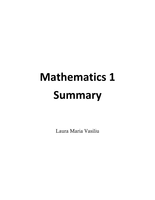Summary
Summary Mathematics 1
- Module
- Institution
- Book
This summary comprises all you need to know for the Mathematics 1 course of IBA! The summary can also be used for any other courses that make use of the book: "Mathematics for Business Economics", H. Hamers, B. Kaper and J. Kleppe, Academic Service, ISBN 978 90 395 2677 4. Good luck!
[Show more]











